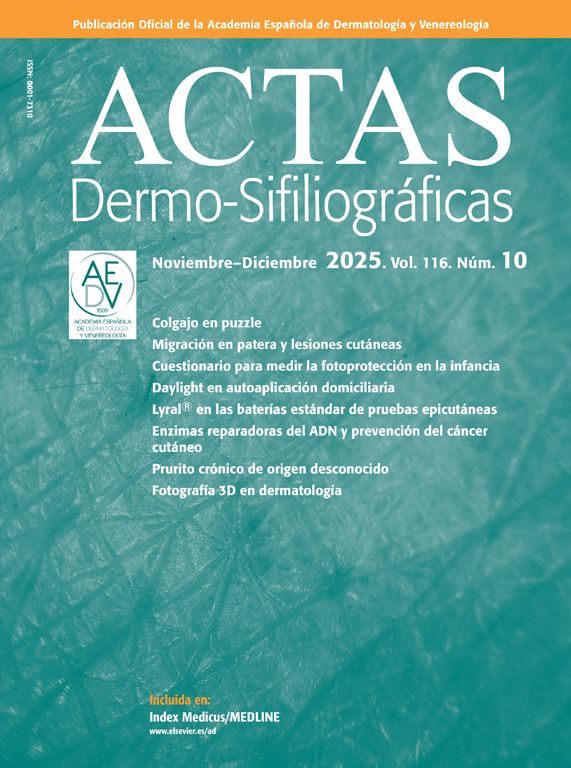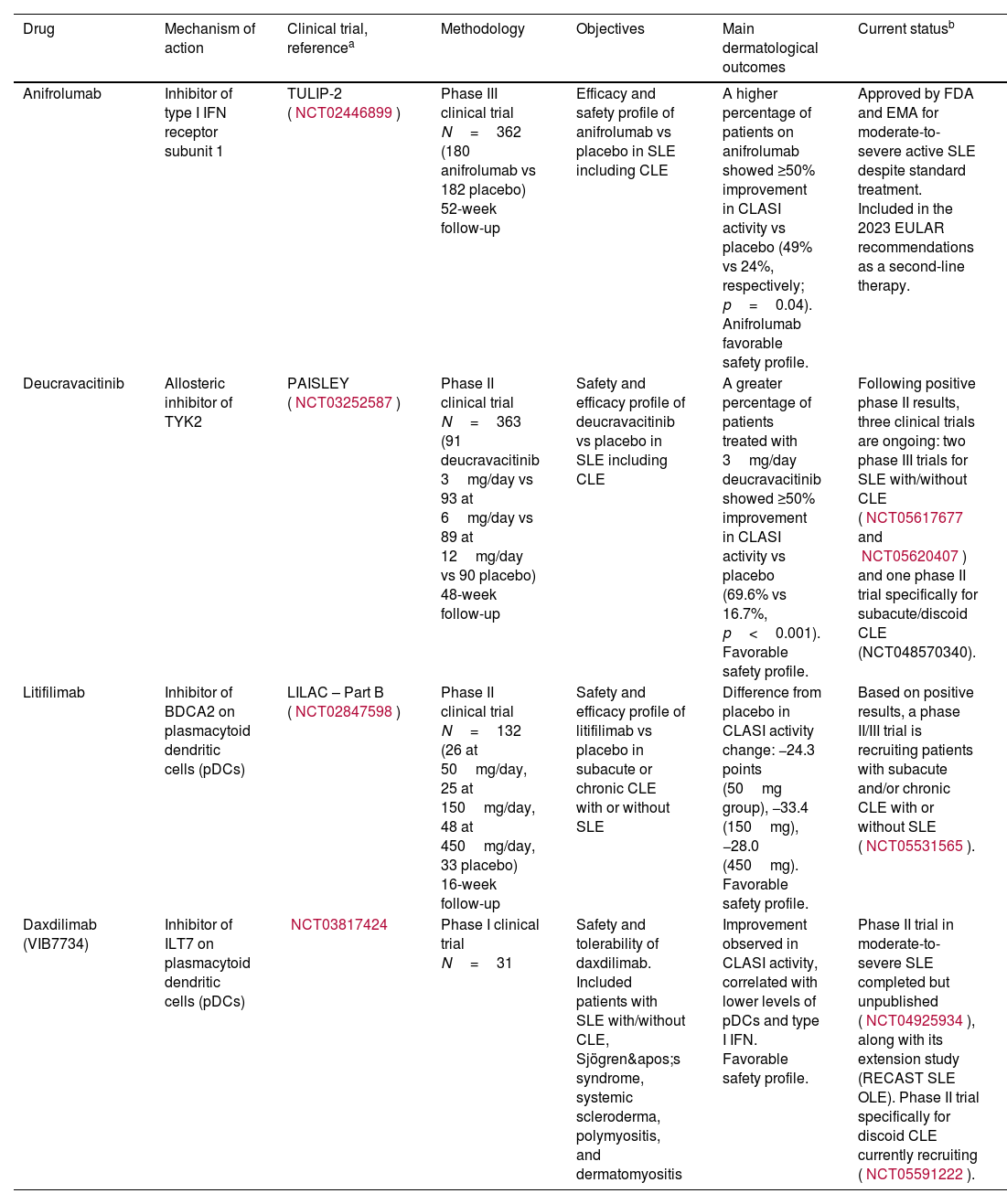In the past 60 years, no drug has been approved by the U.S. Food and Drug Administration (FDA) for the treatment of cutaneous lupus erythematosus (CLE), following the approval of hydroxychloroquine and corticosteroids under regulatory standards that predate current clinical trial requirements. As such, in patients who are refractory to or experience adverse effects from these treatments, management has relied on extrapolating therapeutic responses in other organs affected by systemic lupus erythematosus (SLE) to the skin. Numerous therapies have been used off-label in CLE, including methotrexate, mycophenolate mofetil, dapsone, retinoids, thalidomide, and lenalidomide, among others.1 Recently, two new biologic agents have been added to the therapeutic arsenal: rituximab and belimumab. The former, an anti-CD20 monoclonal antibody, is generally used to treat severe forms of SLE, such as cardiopulmonary, neuropsychiatric, or renal involvement, while its efficacy profile in CLE is less well defined and supported by limited evidence.2 In contrast, belimumab is another monoclonal antibody that inhibits B cells by specifically binding to the B-lymphocyte stimulator protein (BLyS). It has demonstrated efficacy over placebo in treating mucocutaneous signs of lupus and reducing disease flares, although its maximum therapeutic effect may take up to a year to manifest.3
In a recent article, the group led by Victoria P. Werth reviewed the latest advances in clinical trials for CLE.1 In addition to the above-mentioned drugs, several promising agents for the treatment of SLE and CLE were highlighted (Table 1). Anifrolumab, a selective inhibitor of the type I interferon receptor subunit 1, has recently been approved by both the FDA and the European Medicines Agency (EMA) for the treatment of moderate-to-severe SLE, following the results of its phase III trials TULIP-1 and TULIP-2. The latter specifically evaluated cutaneous involvement using the Cutaneous Lupus Erythematosus Disease Area and Severity Index (CLASI) and found a significant ≥50% improvement in CLASI activity vs placebo (49% vs 24%, respectively; p=0.04). A phase II/III trial specifically assessing this drug in CLE is currently underway.1 These results have been corroborated in numerous recent case series in real-world clinical practice.4 Deucravacitinib, a selective tyrosine kinase 2 (TYK2) inhibitor approved for the treatment of plaque psoriasis, showed promising results in the phase II PAISLEY trial: a higher proportion of patients treated with deucravacitinib 3mg/day achieved a ≥50% improvement in CLASI activity vs placebo (69.6% vs 16.7%, respectively; p<0.001), prompting the launch of further trials.1 Finally, two novel agents – lifitilimab and daxdilimab – have shown promising results in early-phase clinical trials for both SLE and CLE.1 These drugs selectively inhibit plasmacytoid dendritic cells, which play a key role in initiating and sustaining the inflammatory cascade in lupus through the production of various types of interferons and other cytokines.5
New drugs for the treatment of systemic and cutaneous lupus erythematosus.
| Drug | Mechanism of action | Clinical trial, referencea | Methodology | Objectives | Main dermatological outcomes | Current statusb |
|---|---|---|---|---|---|---|
| Anifrolumab | Inhibitor of type I IFN receptor subunit 1 | TULIP-2 (NCT02446899) | Phase III clinical trial N=362 (180 anifrolumab vs 182 placebo) 52-week follow-up | Efficacy and safety profile of anifrolumab vs placebo in SLE including CLE | A higher percentage of patients on anifrolumab showed ≥50% improvement in CLASI activity vs placebo (49% vs 24%, respectively; p=0.04). Anifrolumab favorable safety profile. | Approved by FDA and EMA for moderate-to-severe active SLE despite standard treatment. Included in the 2023 EULAR recommendations as a second-line therapy. |
| Deucravacitinib | Allosteric inhibitor of TYK2 | PAISLEY (NCT03252587) | Phase II clinical trial N=363 (91 deucravacitinib 3mg/day vs 93 at 6mg/day vs 89 at 12mg/day vs 90 placebo) 48-week follow-up | Safety and efficacy profile of deucravacitinib vs placebo in SLE including CLE | A greater percentage of patients treated with 3mg/day deucravacitinib showed ≥50% improvement in CLASI activity vs placebo (69.6% vs 16.7%, p<0.001). Favorable safety profile. | Following positive phase II results, three clinical trials are ongoing: two phase III trials for SLE with/without CLE (NCT05617677 and NCT05620407) and one phase II trial specifically for subacute/discoid CLE (NCT048570340). |
| Litifilimab | Inhibitor of BDCA2 on plasmacytoid dendritic cells (pDCs) | LILAC – Part B (NCT02847598) | Phase II clinical trial N=132 (26 at 50mg/day, 25 at 150mg/day, 48 at 450mg/day, 33 placebo) 16-week follow-up | Safety and efficacy profile of litifilimab vs placebo in subacute or chronic CLE with or without SLE | Difference from placebo in CLASI activity change: −24.3 points (50mg group), −33.4 (150mg), −28.0 (450mg). Favorable safety profile. | Based on positive results, a phase II/III trial is recruiting patients with subacute and/or chronic CLE with or without SLE (NCT05531565). |
| Daxdilimab (VIB7734) | Inhibitor of ILT7 on plasmacytoid dendritic cells (pDCs) | NCT03817424 | Phase I clinical trial N=31 | Safety and tolerability of daxdilimab. Included patients with SLE with/without CLE, Sjögren's syndrome, systemic scleroderma, polymyositis, and dermatomyositis | Improvement observed in CLASI activity, correlated with lower levels of pDCs and type I IFN. Favorable safety profile. | Phase II trial in moderate-to-severe SLE completed but unpublished (NCT04925934), along with its extension study (RECAST SLE OLE). Phase II trial specifically for discoid CLE currently recruiting (NCT05591222). |
BDCA2, blood dendritic cell antigen 2; pDC, plasmacytoid dendritic cell; CLASI, Cutaneous Lupus Erythematosus Disease Area and Severity Index; EMA, European Medicines Agency; EULAR, European League Against Rheumatism; FDA, Food and Drug Administration; IFN, interferon; ILT, immunoglobulin-like transcript 7; CLE, cutaneous lupus erythematosus; SLE, systemic lupus erythematosus; TYK2, tyrosine kinase 2.
The broad heterogeneity of mucocutaneous signs in SLE and CLE, as well as variability in treatment response, largely depends on the relative contribution of different interleukins, inflammatory mediators, and cellular components involved in disease pathogenesis. This concept, known as the inflammatory phenotype in CLE, may help explain the success or failure of the therapies discussed in this update.2,3 With advances in understanding the pathophysiology of this disease, new therapeutic options are expected to emerge in the coming years for patients with SLE and, particularly, CLE – both of which have lacked novel treatments for the past six decades.




